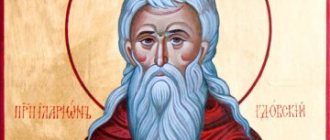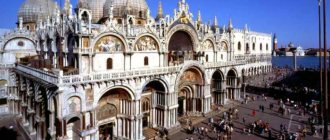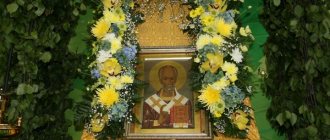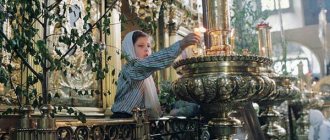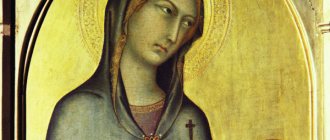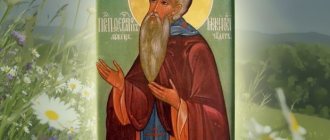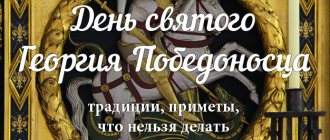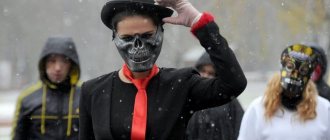Full version of the site -> Mobile version
Today on the calendar: Holidays and events
Events that occurred on July 24 in the world, in various years.
Folk calendar
Efimya Stozharnitsa.
Olga Stradnitsa... Orthodox calendar
of the Great Martyr Euphemia All-Praised.
Equal to the Apostles Grand Duchess Olga of Russia, in holy baptism Helena. St. Arkady of Vyazemsky, Novotorzhsky... Holidays and memorable days of Russia
Holidays are expected: 07.26.2021 - Parachutist Day. 07/28/2021 - Day of the Baptism of Rus'. PR Specialist Day. 08/01/2021 - Logistics Day of the Armed Forces of the Russian Federation. Collector's Day.
All the holidays...
A calendar is a system for counting long periods of time, based on the periodicity of such natural phenomena as the change of day and night, the change of phases of the Moon, and the change of seasons.
Calendar - (from Latin calendae or kalendae, “calends” - the name of the first day of the month among the ancient Romans), a way of dividing the year into convenient periodic time intervals. The main tasks of the calendar are: a) fixing dates and b) measuring time intervals.
The first calendars arose a long time ago, in ancient times, because there was a need to measure time. The word calendar comes from the Latin words caleo - to proclaim and calendarium - debt book. In Ancient Rome, debtors paid interest on the day of the calendar, the first days of the month) - a number system for large periods of time based on the periodicity of the movement of celestial bodies: the Sun - in solar calendars, the Moon - in lunar calendars, and at the same time both the Sun and Moon in lunisolar calendars .
The calendar allows you to record historical and social events in their chronological sequence. One of the important tasks of the calendar is to determine the moments of church events, moving and non-moving holidays (for example, Easter).
There are three main types of calendars: 1) lunar, 2) solar and 3) lunisolar.
1. Lunar calendar, which is based on a synodic lunar month with a duration of 29.5 average solar days. Originated over 30,000 years ago. The lunar year of the calendar contains 354 (355) days (11.25 days shorter than the solar one) and is divided into 12 months of 30 (odd) and 29 (even) days each (Muslim, Turkish, etc.). The lunar calendar is adopted as a religious and state calendar in the Muslim states of Afghanistan, Iraq, Iran, Pakistan, the United Arab Republic and others. Solar and lunisolar calendars are used in parallel for planning and regulating economic activities.
2. Solar calendar, which is based on the tropical year. Originated over 6000 years ago. Currently accepted as the world calendar. For example, the “old style” Julian solar calendar contains 365.25 days. Developed by the Alexandrian astronomer Sosigenes, introduced by Emperor Julius Caesar in Ancient Rome in 46 BC and then spread throughout the world. In Rus' it was adopted in 988 NE. In the Julian calendar, the length of the year is determined to be 365.25 days; three “simple” years have 365 days each, one leap year has 366 days. There are 12 months in a year of 30 and 31 days each (except February). The Julian year lags behind the tropical year by 11 minutes 13.9 seconds per year. The error per day accumulated over 128.2 years. Over 1500 years of its use, an error of 10 days has accumulated. In the "new style" Gregorian solar calendar, the length of the year is 365.242500 days (26 seconds longer than the tropical year). In 1582, the Julian calendar, by order of Pope Gregory XIII, was reformed in accordance with the project of the Italian mathematician Luigi Lilio Garalli (1520-1576). The counting of days was moved forward by 10 days and it was agreed that every century that is not divisible by 4 without a remainder: 1700, 1800, 1900, 2100, etc. should not be considered a leap year. This corrects an error of 3 days every 400 years. An error of 1 day “accumulates” in 3323 years. New centuries and millennia begin on January 1 of the “first” year of a given century and millennium: thus, the 21st century and the 3rd millennium AD (AD) began on January 1, 2001 according to the Gregorian calendar. In our country, before the revolution, the “old style” Julian calendar was used, the error of which by 1917 was 13 days. On February 14, 1918, the world-accepted “new style” Gregorian calendar was introduced in the country and all dates moved forward 13 days. The difference between the old and new styles is 11 days in the 18th century, 12 days in the 19th century, and 13 days in the 20th century - lasting until 2100. The solar calendar is usually based on four main dates - two equinoxes and two solstices. The accuracy of a calendar is determined by how accurately the equinox falls on the same day each year. The lunisolar calendar is an attempt to harmonize the length of the lunar month and the solar (tropical) year through periodic adjustments. To ensure that the average number of days per year according to the lunar calendar corresponds to the solar year, a thirteenth lunar month is added every 2 or 3 years. This trick is required to ensure that the growing seasons fall on the same dates each year.
3. Lunisolar calendar, in which the movement of the Moon is coordinated with the annual movement of the Sun. The year consists of 12 lunar months of 29 and 30 days each, to which “leap” years containing an additional 13th month are periodically added to take into account the movement of the Sun. As a result, “simple” years last 353, 354, 355 days, and “leap” years last 383, 384 or 385 days. It arose at the beginning of the 1st millennium BC and was used in Ancient China, India, Babylon, Judea, Greece, and Rome. Currently adopted in Israel (the beginning of the year falls on different days between September 6 and October 5) and is used, along with the state one, in the countries of Southeast Asia (Vietnam, China, etc.).
Next: History of calendars...
Calendar of national holidays and will accept for every day
One season always replaces another and this determines a person’s way of life. In connection with this, a folk calendar was formed in which there were practically no nameless, unmarked days. Every day was special, had its own purpose. All this was determined by climate conditions and astrological phenomena. In Rus', the calendar was called a monthly calendar. The month book covered the entire year of peasant life, “describing” day by day, month after month, where each day had its own holidays or weekdays, customs and superstitions, traditions and rituals, natural signs and phenomena. The cyclical nature of the calendar is reminiscent of human life, where spring is youth, summer is heyday, autumn is the time of harvesting fruits (it’s good if there are some, otherwise you can live your life without collecting fruits), winter is the time of wisdom and peace. This cyclicality and rhythm determined the way of life of the farmer. The folk calendar was an agricultural calendar, which was reflected in the names of the months, folk signs, rituals and customs.
For each person, the only way to avoid the constant danger lurking in the world around him was to find a system of explanations for this incomprehensible world. For this purpose, each nation has created its own system of predicting events and signs. It is known that in each region there are thousands of folk signs that are characteristic only of this place. But over time, our ancestors developed a coherent, unified system of signs and predictions based on natural phenomena. This is how a yearly calendar cycle was formed, with which we invite you to familiarize yourself with the Folk Calendar of Russian Folk Signs...
Martyr Huar and with him the seven martyrs, Christian teachers
October 19 (November 1) marks 1700 years since the holy death of the martyr Huar. Saint Uar († 307), who lived in Alexandria in Egypt, was a military leader and a secret Christian. Fearing the lawless idolaters, he hid his faith. During the persecution, Saint Uar walked around the dungeons at night and looked after the Christians imprisoned in them. One day he visited a prison in which seven Christian teachers were imprisoned. Saint War asked them to pray so that he could get rid of the fear of torment and suffer for Christ. “If you are afraid of temporary torment, then you will not escape eternal torment; if you are afraid to confess Christ on earth, then you will not see His face in Heaven,” they answered. Hearing this, Saint Uar felt within himself such love for God that he decided to endure suffering for His Name and remained in prison. In the morning one of the martyrs died from his wounds. Saint Huar, appearing together with six teachers before the governor, expressed a desire to suffer in place of the deceased prisoner. They beat Saint Huar with sticks and planed them with iron knives, then, nailing him upside down to a tree, they tore off the skin from his back, and tormented his belly until all his entrails fell out to the ground. His fellow prisoners prayed for him and inspired him to achieve heroism. A few hours later Saint War died. The torturers dragged his body out of the city and threw it to be devoured by dogs.
One pious widow, blessed Cleopatra, secretly brought him into her house at night and buried him in her bedroom. Constantly lighting candles over the tomb of Saint Huar, Cleopatra prayed fervently. When the persecution subsided, she returned to Palestine, placing the relics of the saint in the ancient tomb of her ancestors. Every day she went there, lighting candles and censing. Following her example, other Christians began to resort to the prayers of Saint War and received healings at his tomb. Then Blessed Cleopatra decided to build a temple in honor of the martyr. By that time, her son John had reached the age of seventeen, and Cleopatra asked the king for an honorary position in the army for him. She fervently prayed to Saint Huar, calling on him to be a helper to her son, to ask the Lord for what would be pleasing to Him and useful to his son.
After the consecration of the temple, the relics of Saint Huar were placed under the altar, on which the Divine Liturgy was celebrated. After the service, Blessed Cleopatra prepared a meal for the guests and served them together with her son. Suddenly John fell ill with a fever and died at midnight, leaving his mother in inconsolable grief. Weeping, blessed Cleopatra rushed to the temple and, falling to the tomb, began to reproach the holy martyr. From extreme fatigue and great sorrow, she fell asleep right next to the coffin. In a dream, Saint Uar appeared to her along with her son. Both of them, dressed in clothes whiter than snow, were as bright as the sun. The saint rebuked her for murmuring and promised to take her with him as soon as it was God’s will. Blessed Cleopatra felt unspeakable joy. Together with the priests, she buried her son at the tomb of Saint Huar, no longer crying, but rejoicing in the Lord. Having renounced the world and distributed her property to the needy, Cleopatra began to live at the church of St. War, spending day and night in fasting and prayer. Every Sunday during prayer, Saint War appeared to her with her son. After spending seven years in such labors and pleasing God, blessed Cleopatra reposed in 327.
The Holy Martyr Uar is especially loved by the Russian people. People resort to his intercession, asking for petitions for the health of infants and young children, and for easing the lot of infidels. The veneration of the holy martyr Uar in the Russian Church is closely connected with the prayerful appeal to the holy righteous Artemy of Verkolsky and the noble prince Demetrius of Uglich. On the day of remembrance of the holy martyr Huar in 1582, the holy prince Demetrius was born. A chapel was built in the Kremlin Archangel Cathedral in honor of the martyr Huar. The icon of Saint Uar from this side-chapel is known, painted according to the vow of Queen Mary Nagaya according to the height of Saint Demetrius.
Calendar of Russian folk signs
Season: Winter - December, January, February. Season: Spring - March, April, May. Time of year: Summer - June, July, August. Season: Autumn - September, October, November.
New Martyrs and Confessors of Russia
Hieromartyr Sergius Pokrovsky (September 5, 1880 - November 1, 1937)
“You were a secret agent and therefore were not put on trial for your revolutionary work at that time. Do you admit it? – the investigator asked Father Sergius during interrogation in August 1937.
- I deny this. I have never been a secret agent anywhere. I was not put on trial thanks to the protection of my school friend, the son of a bailiff.”
The life path of the future martyr was atypical - for several years he was in the Socialist Revolutionary Party. But after being ordained and beginning his ministry, he left the party and devoted 30 years to the Church, right up to martyrdom for the faith.
Read a short life
The unrest in the Kaluga seminary, where Sergei Nikolaevich, the son of a psalm-reader, studied, continued for several years: unrest among students, disobedience to authorities, secret meetings of socialist-oriented circles in the forest, in pubs and in private apartments. After graduating from the seminary in 1904, Sergei Nikolaevich worked as a teacher in the village, and since 1905 he propagandized among peasants and teachers for the Socialist Revolutionary Party, distributed literature and almost ended up in prison. One of the school educational performances in November 1905 almost ended in chaos - so violently did those gathered express dissatisfaction with the tsarist system. What saved the teacher from investigation and arrest was a letter to a friend of the bailiff’s son: he persuaded him not to arrest him and the case was hushed up.
In 1907, Sergei Nikolaevich was ordained a priest at the church; in 1908 he left the party. He devoted his further life to serving God and his flock in the church in the village of Nikitskoye, Medynsky district, Kaluga province. In any weather and at any time of the day, he went to fulfill the services, often served and always preached. When the persecution began, Father Sergius was forced to renounce his rank, promising to save his life. In Medyn at that time, significantly more priests suffered than in other places in Kaluga land. And Father Sergius understood what was ahead of him.
In 1937, the priest was arrested. During interrogations, he was accused of counter-revolutionary work at the temple, of participation in the uprising in 1918, of anti-collective farm agitation, and of praising Hitler and fascist Germany. He refused to admit the charges and was sentenced to death. Archpriest Sergius Pokrovsky was shot in the city of Medyn on November 1, 1937 and buried in an unknown grave.
After the arrest of the priest and his martyrdom, the parishioners did not leave his orphans without help, despite the danger of being accused of sympathizing with the “enemies”: they brought food most often at night, sharing the last piece of bread.
According to the Medyn district newspaper “Zarya”, in 2021, in memory of her grandfather, the granddaughter of Father Sergius, Larisa Aleksandrovna Tomshina, reconstructed his house. On the day of consecration, a memorial plaque was attached to the house. Residents of the village of Nikitskoye stand a chapel on the site of the temple where the holy martyr Sergius of Pokrovsky served.
Collapse
Holidays, dates and events of the year. All state and professional holidays in Russia
The holiday has always kept pace with the history of mankind. Social time can be divided into three types: everyday life (weekdays), weekends and holidays. Everyday life is a series of practices repeated day after day (work). Weekends are regular breaks from the rush of everyday life. It is believed that on weekends a person should restore his strength after working days. Day off, non-working day. A holiday is a day of celebration... more...
Prophet Joel
The Orthodox Church honors the memory of one of the minor prophets, through whom God prophetically announced the outpouring of the Holy Spirit, which occurred on the Day of Pentecost.
The prophet Joel lived in a difficult time for his people.
The drought dried up all water sources, caterpillars, locusts and beetles destroyed crops and fruits.
In modern terms, the children of Israel were experiencing a great economic crisis.
“The field is desolate, the earth mourns; For the bread is destroyed, the grape juice is dried up, the olive tree withers.
Blush with shame, O farmers; weep, O vinedressers, for the wheat and barley, because the harvest in the field perished, the vine withered, and the fig tree withered; the pomegranate tree, the palm tree and the apple tree, all the trees in the field withered; therefore the joy of the sons of men disappeared.
Gird yourselves and weep, priests! howl, altar servers! Come in, sleep in sackcloth, O servants of my God! for your grain offering and drink offering are no longer in the house of God,” this is what the prophet writes about what happened to God’s people (Joel 1:10-13).
All sectors suffered from this disaster: cattle breeding, agriculture, bread and wine production. The Prophet Joel begins to appeal to Israel on behalf of God and call them to repentance, fasting and prayer.
These disasters befell the people not in vain, but because their hearts grew cold towards God.
Therefore, when the prophet calls on people to rend their hearts in repentance, he immediately says: “... and not your clothes,” demanding sincere contrition and repentance.
He also speaks about hope, encouraging people and instilling in them that after repentance and fasting, after contrition of hearts and fervent prayer, the Lord will have mercy on them:
“Then the Lord will be jealous for His land, and will spare His people” (Joel 2:18), writes Joel.
This prophet is also quoted by the Evangelist and Apostle from Luke 70, who conveys to us the sermon of the Apostle Peter on the day of Pentecost, he writes:
“But this is what was foretold by the prophet Joel:
And it shall come to pass in the last days, saith God, that I will pour out my Spirit on all flesh, and your sons and your daughters shall prophesy; and your young men will see visions, and your old men will dream dreams.
And on My servants and on My handmaids in those days I will pour out My Spirit, and they will prophesy.
And I will show wonders in heaven above and signs on the earth below, blood and fire and smoking smoke” (Acts 2:16-19).
The Apostle Peter, quoting the words of the prophet, explains that the long-awaited prophecy, which had been awaited since the time of Joel, was fulfilled.
On this day, the Holy Spirit descended on the apostles, who were in prayer after the ascension of Jesus Christ, and they began to prophesy and teach people about Christ in different languages, since at that time there were many people from different countries at the holiday.
This sign, the speaking of foreign languages in unfamiliar languages, which happened to the apostles, was supposed to surprise people and turn their hearts to Christ.
As the prophet writes:
“And it shall come to pass that whoever calls on the name of the Lord will be saved; For in Mount Zion and in Jerusalem there will be salvation, as the Lord has said, and for the rest whom the Lord will call” (Joel 2:32).
vThe Church from ancient times revered the prophet Joel, and this is reflected in its hymnography in the prayerful glorification of the holy prophet:
“Foretelling the coming of God in the flesh and the influx of the Holy Spirit and the coming Judgment, prophesied Joel: save with your prayers those who honor you from all sorrows.”
Eastern calendar for every day
The Eastern calendar, which has been in effect for several thousand years in Vietnam, Kampuchea, China, Korea, Mongolia, Japan and some other Asian countries, was compiled during the time of the semi-legendary Emperor Huang Di in the middle of the third millennium BC. This calendar is a 60-year cyclical system... More...
Similar articles
Prayers to the Mother of God for every day of the week Miracle-working icons for every day Day of the Descent of the Holy Spirit. Spiritual Day Eastern, Chinese calendar. History of the Year of the Rat calendar. General character of the eastern sign Rat
calendareveryday.ru © Every day calendar , 2011-2021, Mobile version Rules |
Sitemap | Map of the mobile version of the site
Orthodox history of the holiday Midsummer November 1, 2020
John was born at the end of the 9th century into an ordinary family in the village of Skrino. From a young age he was a novice in a monastery, it was there that he learned to read and write and studied theological books with interest. After some time, he took monastic vows and began to live in the forest. At first he built a hut from brushwood, and later moved into a cave. Pilgrims who needed privacy began to settle nearby. And so the monastery was soon formed. The Monk John became abbot and guided people on the true path.
30 years after the death of John, he appeared in a vision to the abbot of the Rila Monastery and asked the abbot to transfer his relics to the city of Sredets, which is now known as Sofia. When people opened his grave, they found the saint’s relics incorrupt.
Reading the Gospel:
Gospel of Luke, chapter 8, verses 5 - 15
Read excerpt
5 The sower went out to sow his seed, and as he sowed, some fell by the wayside and was trampled, and the birds of the air devoured it; 6 And some fell on a rock and came up and withered, because it had no moisture; 7 And some fell among the thorns, and the thorns grew up and choked them; 8 And some fell on good ground and sprang up and bore fruit a hundredfold. Having said this, he exclaimed: whoever has ears to hear, let him hear! 9 And His disciples asked Him, “What is the meaning of this parable?” 10 He said: To you it has been given to know the secrets of the kingdom of God, but to others in parables, so that seeing they do not see and hearing they do not understand. 11 This is what this parable means: the seed is the word of God; 12 But those who fell along the way are the ones who listen, to whom the devil then comes and takes away the word from their hearts, so that they do not believe and are saved; 13 And those who fell on the stone are those who, when they hear the word, receive it with joy, but who have no root, and believe for a time, but fall away in time of temptation; 14 But those who fell among the thorns are those who hear the word, but go away and are overwhelmed by cares, riches, and the pleasures of this life and do not bear fruit; 15 But those that fell on the good ground are those who, having heard the word, keep it in a good and pure heart and bear fruit with patience. Having said this, He exclaimed: whoever has ears to hear, let him hear!
Collapse
Priest Pavel (Velikanov) comments
Features of Orthodox worship
A lot of bewilderment arises among those who for the first time decided to participate with their children in the main sacrament of our Church. How to prepare for communion for a child? What prayers should you read? Is it possible for pregnant or nursing mothers to meet all the requirements? The answers of experienced priests to several of the most popular questions in our material “How to prepare for communion?”
Read the sequence of the Liturgy
Historical events
1512 - the ceiling of the Sistine Chapel, painted by Michelangelo, was shown to the public for the first time.
1520 — The Strait of Magellan is open.
1896 — a picture showing a woman’s naked breasts appears for the first time in National Geographic magazine.
1897 - Students of the University of Turin founded the famous Italian football club Juventus.
1914 - World War I: Britain's first naval defeat at the Battle of Coronel off the coast of Chile.
1939 — the first rabbit born after artificial insemination was shown to the world.
1950 - assassination attempt on US President Harry Truman.
1952 — in the United States, a hydrogen bomb is being tested for the first time on Eniwetak Atoll.
1993 - The European Union was founded.
1998 — The European Court of Human Rights was established.
Who was born
Antonio Canova, an Italian sculptor, was born in 1757.
1863 – George Parker, American inventor of the fountain pen, founder of the Parker Pen Company.
1880 – Alfred Lothar Wegener, German geophysicist and meteorologist, creator of the theory of continental drift.
1942 – Larry Flynt, American publisher, editor-in-chief of Hustler magazine.
1972 – Toni Collette, Australian film actress.
1973 – Aishwarya Rai, Indian fashion model and actress, winner of the Miss World contest.
1984 – Natalia Tena, British film actress and singer.
Paradise Photo: Screenshot
